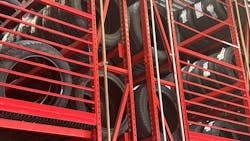Like MTD’s editors, I’m sure you are closely watching events surrounding the possible application of tariffs on medium truck tires that are exported from Thailand to the U.S.
A hearing involving representatives from the United Steelworkers (USW) and a tire company that brings in truck tires from production facilities in Thailand took place on Nov. 7.
During the day-long hearing, there was some discussion about whether tiers of tires exist. As we all know, the answer is, “Yes. Different tiers of tires exist.”
However, one thing that I think has become much less conclusive over the years is how tiers are defined. What determines a tier? In my opinion, that’s one of the more intriguing questions facing our industry, albeit more of an internal question.
I’m not just talking about commercial truck tires, which are in focus right now. I’m talking about consumer tires, ag tires, OTR tires and even retreads. (By the way, for an in-depth look at what was discussed during the early- November TBR tariff hearing, I strongly urge you to read MTD Managing Editor Joy Kopcha’s excellent report, which can be found on page 12 of the December issue.)
What are the “ingredients” that make up a tier-one tire? What constitutes a tier-two tire? How do we define a tier-three tire? What confers tier-four status on a tire or brand? Is it a function of:
Price? Are tiers determined solely by their sellout, retail price point — in other words, what the end user, whether an individual customer or a fleet, shells out for the product? How does the sell-in price from the manufacturer to the dealer or distributor factor into the equation or does it at all? Research shows that many cash-strapped consumers continue to gravitate toward less expensive tires. Others prefer more expensive products. Is this a function of perceived brand or product quality, simply finding a product listed at the right price at the right time or a mix of both?
Technology? All tires sold in this market, to earn Department of Transportation (DOT) approval, must meet certain standards of safety and performance. Therefore, it’s a given that DOT-approved tires contain a certain level of technology achieved through a certain level of research and development, brought into existence via a certain degree of manufacturing expertise and capability. We also know that the aforementioned factors can vary from manufacturer to manufacturer. To what extent do these differences help define tiers?
Marketing? Advertising has been part of the tire industry since day one. (You should see some of the ads in the early issues of Modern Tire Dealer!) Does marketing influence a tire or brand’s tier status? Can a good marketing campaign enhance tier perception? I would argue yes, but as stated above, the tire is still required to pass certain “muster,” according to the government, accepted industry standards and the toughest critic of all, the customer. It’s safe to say that aggressive marketing hampered by poor product technology or lackluster performance is probably not a recipe for repeat business or long-term profitability.
Infrastructure? You can also call this factor “support.” Is there a credible resource that a tire dealer, distributor or end user can turn to in the event of a product issue, a shipping/delivery problem or another complication that might arise? I believe that back-office infrastructure and support — or lack thereof — certainly can determine the perceived tier status of a tire or brand. But how much support is required? Do suppliers need to build and maintain a massive, multi-layered organization to support their customers and products? Is such a structure a “must-have” or simply a “nice-to-have?”
I believe that all of the dynamics listed above contribute to a tire or brand’s tier designation, though if you were forced to depict how they stack up against one another — say, in the form of a pie chart — it could be challenging to assign specific values to each.
One thing that cannot be overlooked is the tire dealer’s role in defining tier. An enterprising tire dealer certainly can take what many would label as a second or third-tier brand or product and make it a top-tier offering within his or her local market.
We’ve seen countless, very successful examples of this over the decades and I believe it isn’t contingent on how customers define tiers.
In fact, I believe that very few, if any, retail tire buyers think in terms of “tiers.” They do believe, however, in the credibility and expertise of their local, preferred tire dealer. And maybe that’s the ultimate determinant of “tier” in our industry?
I’d like to hear your take on the subject. We may not figure out this whole tier thing in one, two or even five conversations, but it will at least be an interesting discussion.
Questions? Comments? Email me at [email protected]
About the Author
Mike Manges
Editor
Mike Manges is Modern Tire Dealer’s editor. A 28-year tire industry veteran, he is a three-time International Automotive Media Association Award winner, holds a Gold Award from the Association of Automotive Publication Editors and was named a finalist for the prestigious Jesse H. Neal Award, the Pulitzer Prize of business-to-business media, in 2024. He also was named Endeavor Business Media's Editor of the Year in 2024. Mike has traveled the world in pursuit of stories that will help independent tire dealers move their businesses forward. Before rejoining MTD in 2019, he held corporate communications positions at two Fortune 500 companies and served as MTD’s senior editor from 2000 to 2010.

